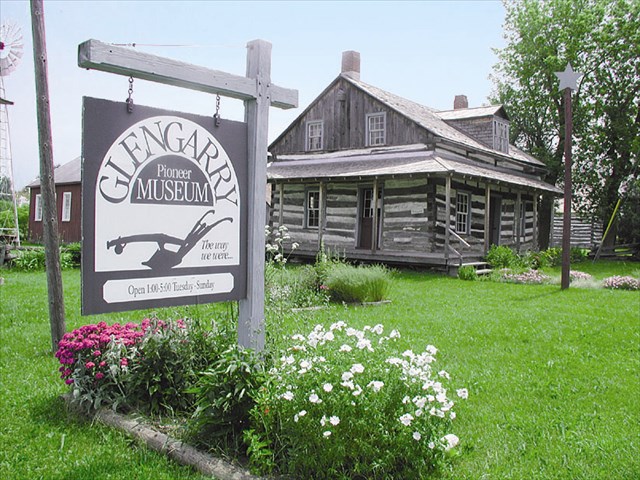This geocache is one of twenty Historical Geo-Passport geocaches within the South Nation Jurisdiction. For more information on this series of geocaches, please visit South_Nation.
Take a brief walk from the parking lot to an open barn, where the hidden geocache awaits.

Histoire / History:
Niché dans le village de Dunvegan, le musée des pionniers de Glengarry compte neuf constructions en rondins incluant le Star Inn des années 1860. Le musée est ouvert en juillet et août, ainsi que durant les fins de semaine et les jours de fête allant de la fête de Victoria jusqu’au mois d’octobre.
Dunvegan doit son nom à la ville située sur l’île de Skye (abritant le château de Dunvegan, domicile du Clan McLeod) en Écosse. La région du comté historique de Glengarry fut colonisée à l’origine en 1792 lorsque plusieurs émigrants écossais arrivèrent des Highlands écossais, suite à l’exode des Highlands. La première vague intense de migration dura jusqu’en 1816, puis l’émigration se poursuivit plus lentement au début du 20e siècle. Plusieurs de ces migrants arrivaient de la région d’Inverness-Shire en Écosse.
Le gaélique canadien / gaélique écossais fut une langue parlée dans la région pendant plus de quatre siècles. Kenyon, qui faisait partie du canton de Charlottenburgh jusqu’en 1798, a été nommé en l'honneur du politicien et juge anglais Lloyd Kenyon, premier Baron de Kenyon.
Le développement dans la région a été fortement stimulé par la construction d’un chemin de fer reliant Ottawa et Montréal dans le début des années 1880. Maxville, Alexandria et Glen Robertson devinrent des carrefours ferroviaires clés pour les fermiers de la région.
********************
Tucked away in the village of Dunvegan is the Glengarry Pioneer Museum, home to nine log buildings including the Star Inn from the 1860’s. Open daily during the months of July and August, and weekends and holidays from Victoria Day to October.
Dunvegan was named after the town located on the isle of Skye (and location of Dunvegan Castle, home of the Clan McLeod), in Scotland. The area was originally settled in 1792, as part of the historic Glengarry County where many Scottish emigrants came from all over the Scottish Highlands due to the Highland Clearances. This first wave of heavy migration lasted till 1816, with emigration continuing into the early 20th century, at a slower pace. Many of these migrants came from the Inverness-shire area of Scotland.
Canadian Gaelic / Scottish Gaelic has been a spoken language in the area for over four centuries. Kenyon, which was part of Charlottenburgh Township until 1798, was named for British judge and politician Lloyd Kenyon, 1st Baron Kenyon.
Development in the region was significantly spurred by the establishment of a railway link between Ottawa and Montreal in the early 1880s. Maxville, Alexandria and Glen Robertson became key railway hubs for farmers in the area.